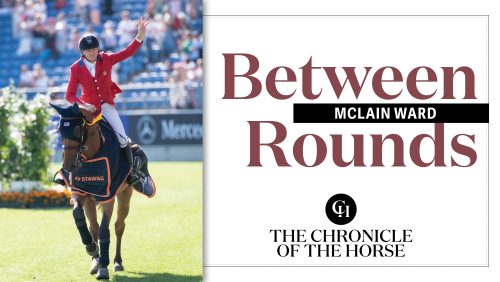Our columnist considers the factors that affect how horses change over time—and whether it’s always for the better.
In December of 1982, while I was riding with Walter Christensen at Stall Tasdorf, near Neumünster, Germany, I had two insights into the way horse breeds change, sometimes for the better and sometimes to the detriment of a breed.
The philosopher Heraclitus, circa 500 B.C., is quoted as saying, “The only constant is change.” Since change is inevitable, can horse breeders actively structure change toward desired results, or are they more apt to be swept along by tides that take good things and ruin them?
Here was the first insight, an example of positive change. Walter said that after World War II, one of the immediate state tasks was to rebuild the bombed out German roads and highways. Once this was accomplished, Walter said that a revolution occurred in German sport horse breeding. He asked us, “Can you guess what ‘invention’ led to huge improvements in the quality of German horses, post World War II?”
We all drew a blank on that, so Walter answered his own question: “It was the invention of the horse trailer.” Prior to that, mares were bred to stallions that the mare could be ridden, driven or led to, and the quality of that local stallion was what you got, good, bad or indifferent.
Once you could load your mare into a trailer and had decent roads on which to travel, your quality options were highly enhanced because your choices of stallions broadened exponentially. When shipped semen came along, that propelled your choices even more dramatically. The advent of frozen semen and easy access to the internet now means that you can stallion shop online, order frozen semen from Germany or the Netherlands, or anywhere, and breed your mare in the field behind your barn in Springfield, Ill., or anywhere else accessible to FedEx or UPS.
Seed Corn Vs. End Product
So that was the good news insight. Now, the not so good.
Walter took me to the stable of a major breeder of Holsteiner dressage horses, and one of the young geldings was spectacular, both in terms of conformation and lofty movement. I asked, “Why would you geld such a lovely young horse?”
He said, “Because this horse is the user end product. You don’t breed a user end product to another user end product to get a third user end product. You breed a heavier mare to a lighter stallion to produce this stamp of horse, and we are starting to run out of those heavier, more ‘old-fashioned’ mares.”
“How is that the case?” I asked.
“Well, in order to get a heavier mare, you need to breed the heavier mare to a heavier stallion and hope that you get a filly,” he said. “But most breeders don’t want to take the chance of getting a heavier type colt, for which there is little market. And even if the breeding produces that ‘old-fashioned’ filly, you still have to wait until she is at least a 3-year-old to breed her, so you are looking at four years down the road, at least, before you produce a horse that the market wants. Breeders that far sighted and breed preservationists are rare, and so the Holsteiner breed is losing its ‘seed corn.’ ”
That was the term he used, as translated, “seed corn,” meaning, I think, not user end product, but the “seed” to get the user end product.
ADVERTISEMENT
I have told this story to breeders from other breeds like the Registered Irish Draught, the Cleveland Bay, even some of the pony breeds, and have gotten lots of nodding heads, and “Our problem, too,” responses.
What the market wants is the horse to ride right now, and most pragmatic breeders breed horses to satisfy the money spending public. I once read a probably only sort of joking comment from some Irish breeder that you only need about two Irish Draught stallions for all of Ireland, his somewhat cynical take being that the average money spender wants that three-quarter bred, or that seven-eighths bred, even that fifteen-sixteenths bred, and wants it right now.
The Cleveland Bay has been so watered down that the breed is in danger of oblivion. The old-fashioned Morgan, sometimes known as the “Lippitt Morgan,” is similarly in declining numbers.
In a sense, there is a dichotomy between the breed purists and the end product users, with the end product users having the economic clout to swing the issue.
Breeding As A Sacred Trust
I’ve been an avid follower of Thoroughbred racing since I fell in love with Native Dancer in 1953, when I was 11. Over the years I’ve gotten some of the various racing magazines like The Blood Horse and The Thoroughbred Times, and I have read all sorts of articles and editorials about how the breed is changing to reflect a changing clientele.
But, that said, I’m not an “insider” in the world of racing, although I am somewhat of an insider into the world of Thoroughbred sport horses, since I’ve been involved for 55 years and have stood about 15 different Thoroughbred stallions to a largely eventing and showing market.
Here’s the gist of what I have read and been told. Back in the 1920s, 1930s, 1940s, 1950s, and even into the 1960s, many of the top breeding and racing stables were owned by “old guard” families who looked upon breeding as something of a sacred trust, not simply as a means of raking in more money. Many of those breeders would rather have bred a Belmont winner than a Kentucky Derby winner, as they considered the 1 ½-mile test to be a truer mark of a champion than the 1 ¼-mile Kentucky Derby. Over time, the scions of those families grew old and died. Newcomers, with new money, began to supplant them. Prominent trainers from the Quarter Horse racing industry became the advisors to this new type of owner, and, gradually, there was a shift toward shorter distances by younger and younger horses to give the owners faster returns on their investments.
As the races gravitated toward 5, 6 and 7 furlongs (a furlong is one-eighth of a mile) the type of Thoroughbred began to change as well. If you look at prints by Paul Brown and Sir Alfred Munnings, you will see a definite “stamp” of horse, broad in the hips and loins, a big, sloping shoulder, a long “snaky” neck, strong forearms and gaskins, an overall appearance of power and substance.
By contrast, say the detractors, the modern Thoroughbred too often resembles a “bullet,” a shorter, more “downhill” looking type, not unlike an Appendix Quarter Horse, a horse to blast out of the gate and sprint for distances less than a mile.
That is, however, a broad generalization in a breed as large as the Thoroughbred, with about 20,000 foals born every year. There are still those “Munnings print” types out there, but they are mixed in with lots of those sprinting bullets.
Take another sport, eventing, and follow a progression (some would call it a regression) from needing a horse that could go up to 18 miles at speeds up to 690 meters per minute on the cross-country day, to needing a horse to go 3 miles at a top speed of 570 meters per minute. The new event horse needs to excel in dressage, so most of the new wave event horses are a mix of old style Thoroughbred with new style warmblood. Some may call this new type a better horse, some a worse horse, but the inescapable fact is that it is a different horse.
“The only constant is change.”
ADVERTISEMENT
I have ridden about a dozen Arabians in about 2,500 miles of endurance races, and the breeders of the hardy “old-fashioned” endurance Arabs tend not to have much good to say about the breeding choices made to create “sea horse” like profiles and spindly legs for the modern show ring.
I’ve been riding Morgans since 1956 and have watched the breed standard change, decade by decade, into a lighter, finer boned horse, that more and more resembles a smaller version of an American Saddlebred. This is another example of a breed that is in danger of losing its “seed corn,” those tough old-fashioned mares that we see in the old photos from the 1890s and early 20th century, pulling sleighs, doctors’ buggies and doing general farm work.
I’m not personally very familiar with America’s largest breed, the Quarter Horse. All I know is what I read, and some of what I read pertains to a split within the breed between horses bred to perform versus horses bred to be judged on conformation “on the line.” It seems strange that there exists such a split, because it would be logical for the best performers to be drawn from those horses that have the best conformation for performance. If there are two “rival” groups of breeders, I guess the saying “Welcome to the Club” applies, because we hear much the same about various breeds. Whether or not a split between performance and halter makes any sense seems to be irrelevant.
The show jumpers I talk to are very positive about the scope and abilities of the modern warmblood “custom-made” athletes that we see in the big grand prix events. They rave about the consistent quality of these athletes, just as the dressage riders rave about the modern custom-made upper-level dressage warmbloods. Both disciplines, however, are dominated by European warmbloods. European breeders have collectively given up personal autonomy to breed associations, and that’s something that is alien thinking to so often “kennel blind” American breeders.
In the United States, if someone has a young stallion, there is nobody to stop him from standing that horse at stud, even though the colt may be an inferior individual or have significant mechanical aberrations. In the European registries, that colt would never be approved by the inspection panels. This rigorous adherence in Europe to enforced quality control has led many riders to say something I have heard and read many times: “If trainers from the 1940s, 1950s and 1960s could come to the modern era in a time machine, the feature that would blow them away would be the immensely better quality of the horses.”
A Livestock Comparison
We may actually find useful insights in looking at dairy cattle, because with dairy cow milk production, there is no “I like this, and I am right” versus “you like that, and you are wrong.”
Dairy cow milk production statistics are black and white. My neighbor, David Brown, has been a dairy farmer for 60 years. He told me that back in the 1950s, before artificial insemination gave breeders easy access to better genetics, a herd of Holstein cows might produce an annual average of 17,000 to 18,000 pounds of milk per year. Today, that same herd might average 30,000 pounds per year.
The major difference between the quality of those earlier herds of dairy cows and today’s herds has something to do with better management but mostly to do with genetics made possible by frozen semen.
Horse breeders have access to superior genetics, too, with a major difference. Horse breeders do not always breed wisely. They’re swayed by all manner of influences and will often breed according to whim and emotion rather than by adherence to strict criteria for soundness, sanity and athleticism.
Horse breeders hold the destinies of their breeds in their hands, and how they make their collective breeding decisions will determine where those breeds will go and, sometimes, whether or not some of those breeds will even survive.
A dog breeder friend told me that the kiss of death for any specific breed of dog was to become so popular that people who were clueless got involved in the breeding and production. It’s not so far removed from the world of horses. Clued in or clueless, who will lead our breeding programs into an inevitably changing future?
Denny Emerson rode on the 1974 World Championships gold-medal eventing team. He served as the U.S. Combined Training Association (now U.S. Eventing Association) president twice and won the USEA Wofford Cup for his lifetime dedication to the sport. At his Tamarack Farm in South Strafford, Vt., and Southern Pines, N.C., he trains horses and riders, and he owns shares in stallions standing at other farms. An original Between Rounds contributor, Emerson began writing his column in 1989.















